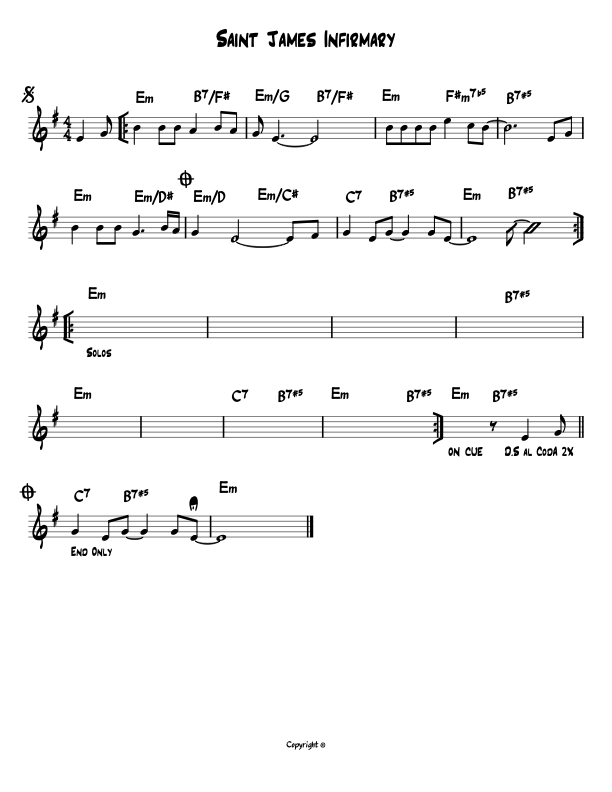"St. James Infirmary Blues" is an American blues song of uncertain origin. Louis Armstrong made the song famous in his 1928 recording on which Don Redman was credited as composer; later releases gave the name Joe Primrose, a pseudonym of Irving Mills. The melody is 8 bars long, unlike songs in the classic blues genre, where there are 12 bars. It is in a minor key, and has a 4/4 time signature, but has also been played in 3/4.

View the Main Song Downloads section below to download the song files for the complete and most up-to-date versions.
"St. James Infirmary Blues" is an American blues song of uncertain origin. Louis Armstrong made the song famous in his 1928 recording on which Don Redman was credited as composer; later releases gave the name Joe Primrose, a pseudonym of Irving Mills. The melody is 8 bars long, unlike songs in the classic blues genre, where there are 12 bars. It is in a minor key, and has a 4/4 time signature, but has also been played in 3/4.

MuseScore Resources
St. James Infirmary Blues - Ukulele Melody and Chord Arrangement with Bass by Curt Sheller
MuseScore is a FREE Open Source and the World’s most popular music notation software with a lot of great sources of scores, tutorials, and reference material. I use it on my iMac and Linux system. Finally get to bag the subscription for Sibelius.
Musescore files can be played back as an aide in learning a song or part.
Workshop for June 28, 2020
- Melody and Bass MP3 Track
- Lead Sheet - Melody, Chords
- Lead Sheet - Melody, Chords, TAB
- Melody, Chords, Sample Bass Line
- Melody Only
Lyrics
Well, folks, I'm goin' down to St. James Infirmary
See my little baby there
She's stretched out on a long, white table
Well, she looks so good, so cold, so fair
Let her go, let her go, God bless her
Wherever she may be
You may search this whole wide world over
But you'll never find another sweetheart like me, yeah
Take apart your bones and put 'em back together
Tell your mama that you're somebody new
Feel the breeze blowin', tell 'em all "Look out, here it comes"
Now I can say whatever I feel like to you
Then get me six craps-shootin' pallbearers
Let a chorus girl sing me a song
Put a red-hot jazz band at the top so that we can raise
Hallelujah as we go along, well
Well, folks, now that you have heard my story
Say, boy, hand me another shot of that rye
And if anyone else should ask you
Just tell 'em I've got some of those St. James Infirmary blues

"St. James Infirmary Blues" is an American blues song of uncertain origin. Louis Armstrong made the song famous in his 1928 recording on which Don Redman was credited as composer; later releases gave the name Joe Primrose, a pseudonym of Irving Mills. The melody is 8 bars long, unlike songs in the classic blues genre, where there are 12 bars. It is in a minor key, and has a 4/4 time signature, but has also been played in 3/4.

Saint James Infirmary (Gambler's Blues) Melody and Sample Bass Line in Em. The bass players role to to outline the chords for a progression, a.k.a the song. Here is a sample to get the fell for what that would sound line.

Saint James Infirmary(Gambler's Blues) leadsheet (Chords and melody) in Em.

Saint James Infirmary (Gambler's Blues) melody only in Em. leadsheet with Ukulele TAB in Em.

Saint James Infirmary(Gambler'Blues) Leadsheet with Sample Bassline - Em. Saint James Infirmary leadsheet with Sample Bass line in Em.

The Blues or Minor Pentatonic is one of six essential scales for ALL ukulele players. One octave scale fingering solutions for strings four and three and any finger with the Blues scale chords are covered in all keys. Sample chord progressions for practice are included. Tunings: C with low or high G - (GCEA or gCEA).

Harmonic Analysis is the understanding of the functional sequence of chords. It is the process used to analyze the harmonic structure of a progression, song or composition. This analysis is then used to make scale selections for improvisation and chord substitution.

Finally, learn the names of the notes of the ukulele fingerboard in C tuning .

Learn the six fingering principles to navigating the ukulele fingerboard. Fingering is one of the most universal topics. Book: Six Secrets of the Ukulele Fingering

Harmonic Analysis is the understanding of the functional sequence of chords. It is the process used to analyze the harmonic structure of a progression, song or composition. Book: Harmonic Analysis for Scale Selection and Chord Substitution

Learn to read single note melodies in the first/open position is a lot easier than you might think. Book: Ukulele – Reading Music Series – Primer

An organized collection of daily practice and reference material for the contemporary ukulele player for developing the vocabulary and knowledge necessary for single note playing. Book: Daily Practice Material for the Contemporary Ukulele
Checkout the Books & Reference Charts for additional Handy, Dandy Reference Charts.

Ukulele Fingerboard Chart for C Tuning, Low or High G – G C E A

Ukulele Fingerboard Chart for G Tuning, Low or High A – D G B E

A handy reference chart of all 15 major and relative minor key signatures. US Letter 8.5 x 11 sized (ANSI-A), A4
Checkout the Books & Reference Charts for additional Handy, Dandy Reference Charts.



.jpg)